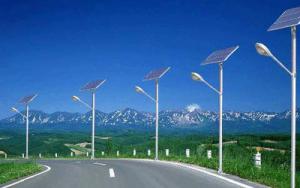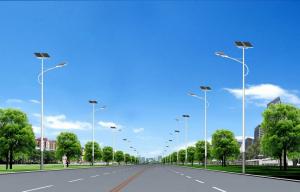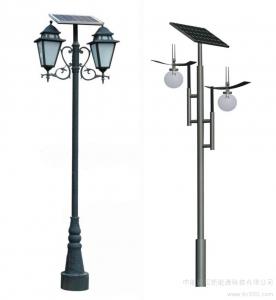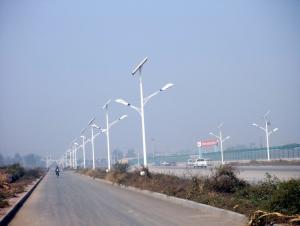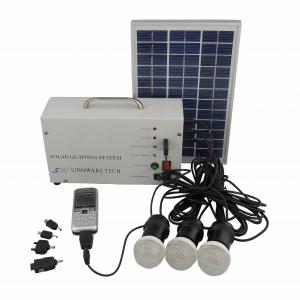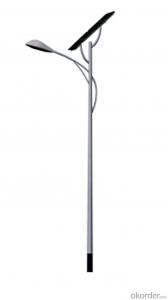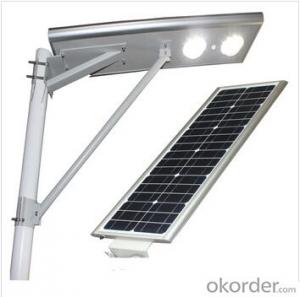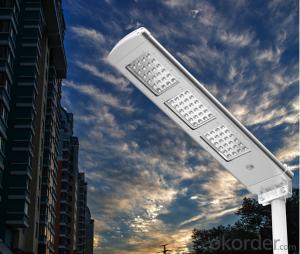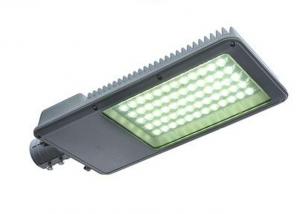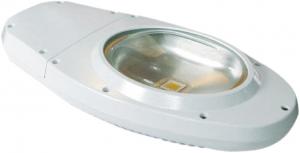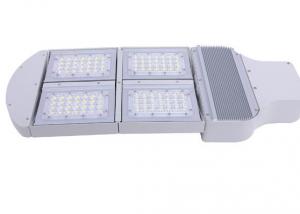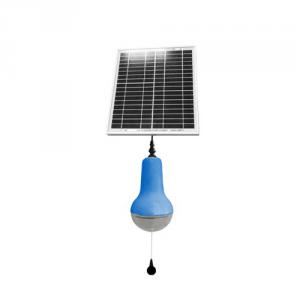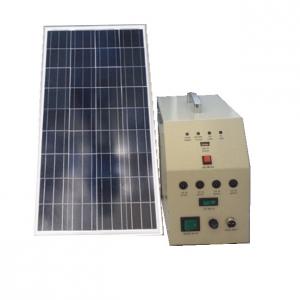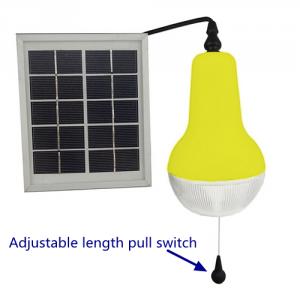Solar Street Lights High Efficicncy R200
- Loading Port:
- Shanghai
- Payment Terms:
- TT or LC
- Min Order Qty:
- 10 pc
- Supply Capability:
- 10000 pc/month
OKorder Service Pledge
OKorder Financial Service
You Might Also Like
1, Product desciption
Inverter circuits designed to produce a variable output voltage range are often used within motor speed controllers.
The DC power for the inverter section can be derived from a normal AC wall outlet or some other source. Control and feedback circuitry is used to adjust the final output of the inverter section which will ultimately determine the speed of the motor operating under its mechanical load.
Motor speed control needs are numerous and include things like: industrial motor driven equipment, electric vehicles, rail transport systems, and power tools. (See related: variable-frequency drive ) Switching states are developed for positive, negative and zero voltages as per the patterns given in the switching Table.
The generated gate pulses are given to each switch in accordance with the developed pattern and thus the output is obtained.
And magnifying glass is then used to warm up the pipe.
Using more than one magnifying glass will increase the temperature more rapidly.
2, Features of the product
Inverters convert low frequency main AC power to higher frequency for use in induction heating.
To do this, AC power is first rectified to provide DC power. The inverter then changes the DC power to high frequency AC power. Due to the reduction in the number of DC Sources employed, the structure becomes more reliable and the output voltage has higher resolution due to an increase in the number of steps so that the reference sinusoidal voltage can be better achieved.
This configuration has recently become very popular in AC power supply and adjustable speed drive applications. This new inverter can avoid extra clamping diodes or voltage balancing capacitors. There are three kinds of level shifted modulation techniques, namely: 1,High and stable conversion efficienly based on over 4 years professional experience
2 ,High reliability with guaranteed +/-10% output power tolerance
3,Proven materials,tempered front glass,and a sturdy anodized aluminum frame allow modules to operate reliably in multiple mountily configurations
4,Combination of high efficicncy and attractive appearance
The first thing to figure out is the length of road in need of street lights.
This can be a small entrance road only a couple hundred of feet long to miles of streets through an area. Does the area currently have any type of lighting available.
What is the reason for needing street lights in this area
Is the electrical grid already nearby or would you need to call in the power company to bring in electrical lines.
If the electric needs to be brought to the area, how much is this going to cost? Depending on how far the grid electric is from the location of the needed lighting, this can be quite expensive.
How much lighting is needed on the street? Do the lights need to be dark sky compliant.
Do the street lights need to run from dusk to dawn or for only a specified number of hours at night.
Are the street lights able to dim in the middle of the night and still provide enough lighting.
These questions need to be answered before you can decide on how many lights you will need to complete the project.
3, Detailed Specification
| ||||||||||||||||||||||||||||||||||||||||||||||||
4, Product Image
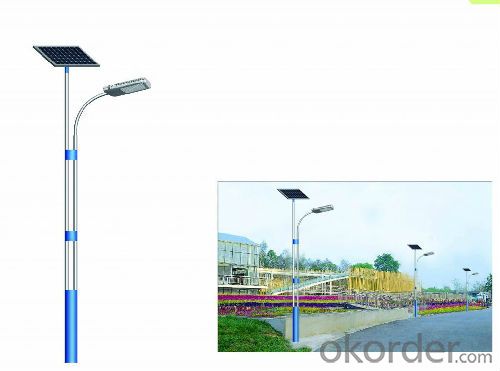
- Q:Can solar lights be used for outdoor art or sculpture lighting?
- Yes, solar lights can definitely be used for outdoor art or sculpture lighting. Solar lights are a great option for illuminating outdoor artworks or sculptures as they don't require any electrical wiring or access to a power source. This makes them convenient and versatile, allowing you to place them in any desired location without the need for professional installation. Solar lights are typically equipped with a small solar panel that absorbs sunlight during the day, storing the energy in a rechargeable battery. As the sun sets, the lights automatically turn on, using the stored energy to emit a gentle and ambient glow. It is important to ensure that the solar lights are placed in an area that receives sufficient sunlight during the day to ensure optimal charging. The versatility of solar lights allows you to easily adjust the lighting angle and intensity to highlight specific features of the artwork or sculpture. Some solar lights even offer different lighting modes, such as steady or flickering, which can add a dynamic element to the lighting design. Additionally, solar lights are typically weatherproof and durable, designed to withstand outdoor conditions such as rain, wind, and UV exposure. This ensures that the lights will continue to function properly and provide reliable illumination for your outdoor art or sculpture, even in challenging weather conditions. Overall, solar lights are a cost-effective and eco-friendly solution for outdoor art or sculpture lighting. They provide a convenient and hassle-free way to illuminate your artwork, while also reducing your carbon footprint and energy consumption.
- Q:Can solar lights be used for outdoor art installations?
- Yes, solar lights can be used for outdoor art installations. They are a sustainable and energy-efficient option that can provide ambient lighting to enhance the visual appeal of the artwork. Additionally, solar lights eliminate the need for wiring or electricity, making them a convenient choice for outdoor installations.
- Q:Do solar lights require any special installation tools?
- No, solar lights do not require any special installation tools. They are typically designed for easy installation and can be set up without the need for any additional tools.
- Q:Can solar lights be used for outdoor theaters?
- Yes, solar lights can be used for outdoor theaters. Solar lights are a great option for outdoor theaters as they are convenient, eco-friendly, and cost-effective. They rely on the sun's energy to charge during the day and illuminate the outdoor space at night. This means that there is no need for electrical wiring or power outlets, making them easy to install and move around. Solar lights also come in various designs and brightness levels, allowing you to create the perfect ambiance for your outdoor theater. Additionally, using solar lights helps reduce energy consumption and their long-lasting nature ensures they can provide illumination throughout the duration of the movie or performance.
- Q:Can solar lights be used for outdoor exhibitions?
- Certainly, outdoor exhibitions can make use of solar lights. Solar lights offer an excellent alternative for outdoor lighting due to their energy efficiency, eco-friendliness, and independence from wiring or electricity. Installation and relocation are hassle-free, requiring no professional help. Moreover, solar lights are available in diverse styles and designs, enabling you to select those that perfectly complement the ambiance and theme of your outdoor exhibition. Furthermore, they emit a gentle and delightful glow, enhancing the exhibition's overall visual appeal.
- Q:Do solar lights have adjustable light distribution patterns?
- Yes, solar lights can have adjustable light distribution patterns. Some solar lights are designed with adjustable heads or lenses that allow you to focus or widen the light beam according to your preference. These adjustable features allow you to customize the light distribution patterns based on the area you want to illuminate or the specific lighting requirements you have. Additionally, certain solar lights may also offer different lighting modes, such as motion sensing or dimming options, which further enhance the flexibility of light distribution patterns.
- Q:Can solar lights be used for public parks or recreational areas?
- Yes, solar lights can be used for public parks or recreational areas. In fact, they are increasingly being utilized in these settings due to their numerous advantages. Solar lights derive their energy from the sun, which means they do not require any electricity or wiring, making them cost-effective and easy to install. They are also environmentally friendly as they do not release any greenhouse gas emissions during operation. Solar lights are typically equipped with sensors that automatically turn them on at dusk and off at dawn, ensuring efficient energy consumption. Additionally, they are low maintenance as they have long-lasting batteries and do not require frequent bulb replacements. By using solar lights in public parks or recreational areas, not only can the area be illuminated during the night for enhanced safety and security, but it can also contribute to the overall sustainability efforts of the community.
- Q:Can solar lights be used for road safety or traffic control?
- Indeed, road safety and traffic control can be achieved by utilizing solar lights. These lights offer a sustainable and cost-effective method to enhance road visibility and ensure the safety of motorists, pedestrians, and cyclists. Installation of solar lights in various locations such as crosswalks, intersections, roundabouts, and construction zones is possible. Solar lights are equipped with photovoltaic panels that absorb sunlight during the day. This absorbed sunlight is converted into electricity and stored in batteries. The stored energy is then used to power the lights at night, providing continuous illumination. Since solar lights rely on solar power, there is no need for external power sources or wiring, making installation and maintenance hassle-free. The use of solar lights for road safety and traffic control brings several advantages. Firstly, these lights offer improved visibility, especially in areas with limited or no access to electricity. They can be strategically placed to mark hazardous areas, curves, or intersections, alerting drivers to potential dangers and reducing the risk of accidents. Moreover, solar lights can be programmed to flash or change colors, serving as warning signals for drivers. For example, in school zones, solar-powered flashing lights can indicate reduced speed limits during specific hours. Similarly, at pedestrian crosswalks, solar lights can flash when a pedestrian activates the crossing signal, notifying drivers to stop and yield. Another benefit of using solar lights for road safety is their ability to function independently during power outages or emergencies. Even during a blackout, solar lights continue to operate, ensuring critical areas remain illuminated and visible to drivers. Furthermore, solar lights contribute to environmental sustainability by reducing reliance on traditional grid electricity and minimizing carbon emissions. They align with global efforts to combat climate change and encourage sustainable development. In conclusion, solar lights are an efficient solution for road safety and traffic control. Their ability to harness solar energy, ease of installation, and low maintenance make them a practical and sustainable choice. By enhancing visibility, providing warning signals, and functioning independently during emergencies, solar lights contribute to creating safer roadways for everyone.
- Q:Are solar lights suitable for remote areas without electricity?
- Remote areas without access to electricity are highly suitable for solar lights. In fact, solar lights are considered one of the most effective lighting solutions for such locations. By harnessing the sun's power, solar lights generate light without the need for any electrical connection or infrastructure. This feature makes them perfect for remote areas where electricity is scarce or nonexistent. Installing solar lights is a hassle-free process and they require minimal upkeep, making them a practical and cost-efficient choice. They can be easily set up in various places, including streets, homes, schools, and community centers, providing essential lighting for both indoor and outdoor spaces. Furthermore, solar lights are environmentally friendly as they do not emit any greenhouse gases or depend on fossil fuels. They play a crucial role in reducing the carbon footprint of these remote areas and contribute to the fight against climate change. Additionally, solar lights offer more than just basic lighting. They can also be used to charge mobile phones or power small appliances, adding to their versatility and value in areas where access to such services may be limited. In summary, solar lights are an outstanding solution for remote areas lacking electricity. They offer a sustainable, affordable, and dependable source of lighting, ultimately enhancing the quality of life and safety for the inhabitants of these areas.
- Q:How do solar lights handle power fluctuations caused by nearby electrical equipment?
- In order to handle power fluctuations caused by nearby electrical equipment, solar lights are designed in several ways. Firstly, they typically come equipped with built-in voltage regulation and control mechanisms. These mechanisms serve to stabilize the power supply and safeguard the light against sudden spikes or drops in voltage, ensuring that it operates safely within an optimal voltage range. Furthermore, solar lights often incorporate surge protection devices as an additional precaution against power fluctuations. These devices are specifically designed to absorb and dissipate excess electrical energy, thereby preventing any potential damage to the light's internal components. Moreover, advanced circuitry may also be present in solar lights to mitigate the impact of power fluctuations. This circuitry is capable of detecting variations in voltage and adjusting the light's power output accordingly. This ensures a consistent and reliable illumination, even when electrical equipment is in close proximity. In summary, solar lights are engineered to withstand power fluctuations caused by nearby electrical equipment. By incorporating voltage regulation mechanisms, surge protection devices, and advanced circuitry, these lights are able to maintain their performance and longevity even in less stable power environments.
1. Manufacturer Overview |
|
|---|---|
| Location | |
| Year Established | |
| Annual Output Value | |
| Main Markets | |
| Company Certifications | |
2. Manufacturer Certificates |
|
|---|---|
| a) Certification Name | |
| Range | |
| Reference | |
| Validity Period | |
3. Manufacturer Capability |
|
|---|---|
| a)Trade Capacity | |
| Nearest Port | |
| Export Percentage | |
| No.of Employees in Trade Department | |
| Language Spoken: | |
| b)Factory Information | |
| Factory Size: | |
| No. of Production Lines | |
| Contract Manufacturing | |
| Product Price Range | |
Send your message to us
Solar Street Lights High Efficicncy R200
- Loading Port:
- Shanghai
- Payment Terms:
- TT or LC
- Min Order Qty:
- 10 pc
- Supply Capability:
- 10000 pc/month
OKorder Service Pledge
OKorder Financial Service
Similar products
New products
Hot products
Hot Searches
Related keywords

